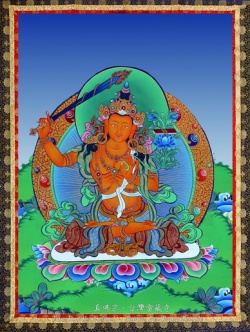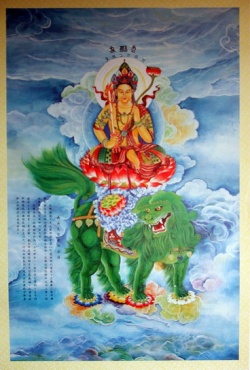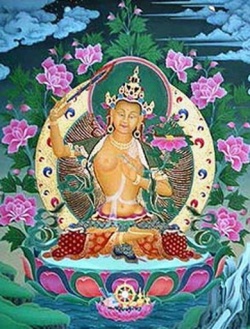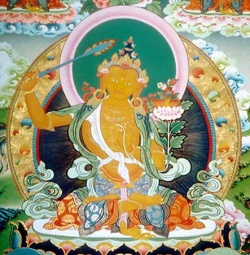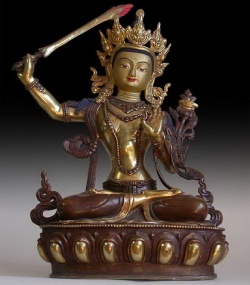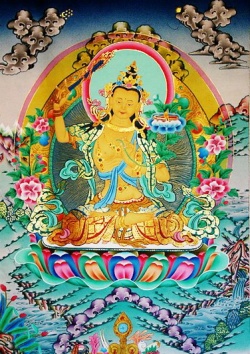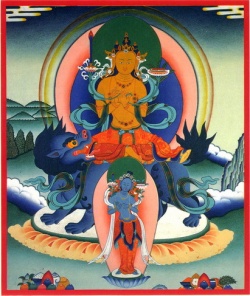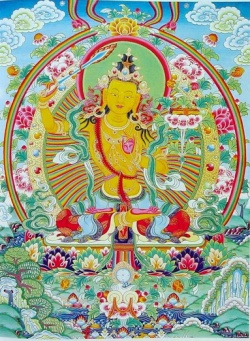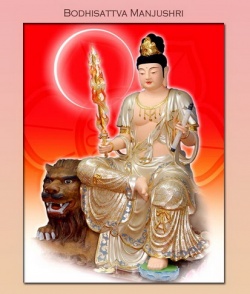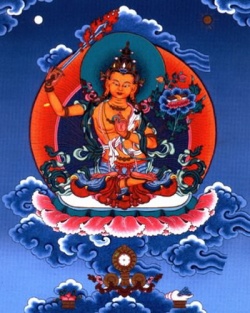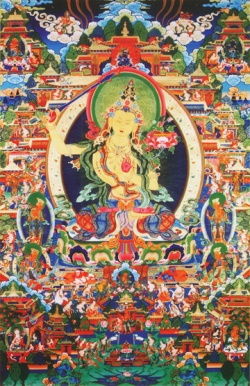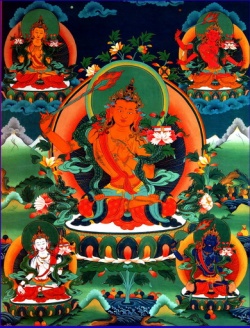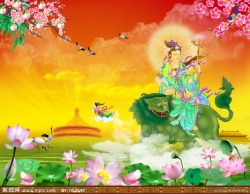The Cult Of Mañju'sri
THE PRESENT ARTICLE examines the question of whether Mañju'srii gained sufficient popularity for it to be possible to speak of a 'cult of Mañju'srii'. 2 The second article in the series illustrated his role and importance in Mahaayaana literature as one of the major Bodhisattvas. 3 However, texts are often normative, that is, they tend to portray what their composers would like to be the case, rather than what is the case. Thus the question of what real religious significance Mañju'srii had in the lives of practising Buddhists in the period covered by the composition of the literature in which he features is separate from the question of his importance in that literature. It is not that texts cannot help in the assessment of what the actual religious situation was at a given time or place. It is rather that they cannot be taken at face value. As with any other form of historical evidence their significance has to be assessed. The sources for an attempt at discovering where and when Mañju'srii's popularity grew in India and Central Asia are, at best, fragmentary. There are the records of the travels of the Chinese Buddhist pilgrims, in particular those of Hsüan-tsang (journeyed 629-645 CE). There is also evidence from surviving iconographic representations of Mañju'srii and other Bodhisattvas in the form of sculptures and murals. There is more substantial evidence for his significance in China, particularly in the form of documents preserved in the Taish< canon. following the pattern of the geographical spread of buddhism, i shall consider, in turn, material from india, central asia and china.
(I) INDIA
IN HIS STUDY The Indian Buddhist Iconography, Benoytosh Bhattacharyya reports that no image of Mañju'srii has been found from Gandhaara or Mathuraa. 4 Lamotte adds that there is no trace of him either at Amaraavatii or Naagaarjunako.n.da. 5 Hsüan-tsang mentions only one image of Mañju'srii in the record of his pilgrimage and David Snellgrove comments that in India there is no identifiable image of Mañju'srii, possibly before the sixth century. 6
Evidence such as this leads Paul Williams to state that 'the iconography of Mañju'srii is a relatively late development'. 7 However, though not inaccurate, such a statement may be misleading. It is true that Mañju'srii's appearance iconographically is later than his appearance in suutras. Yet the evidence, both from the records of the Chinese pilgrims and from surviving images, indicates that his iconographic depiction is not especially late in relation to that of other Bodhisattvas.
Hsüan-tsang notes many images of Maitreya and Avalokite'svara. Taaraa, however, is mentioned by him only twice, and the single reference to Mañju'srii is of a shrine dedicated to him at Mathuraa. 8 Shrines of other Bodhisattvas are referred to without being named. Hsüan-tsang, though a Mahaayaanist of the Yogaacaara school, is particularly interested in sites and legends related to episodes in the life or previous lives of 'Saakyamuni and in the lives of his major disciples. He records these in detail. Snellgrove suggests that the reason for the lack of reference to images of Mañju'srii and other Bodhisattvas by Hsüan-tsang is that such figures were not fully distinguished iconographically at that time. He argue that commonly accepted iconographic differentiation of Buddhas and Bodhisattvas is likely to occur much later than the appearance of the suutras that can be seen as reflecting their popularity in particular circles.
Such an account of the evidence from Hsüan-tsang's diaries is supported by the iconographic evidence that does survive. In addition to Gandhaara and Mathuraa, Mañju'srii is unknown at Ajantaa, where work on the caves continued into the seventh century. He is found, however, in Ellora (7th-10th century), along with Taaraa, Avalokite'svara, Maitreya and Sarasvatii (cave 10), as well as in the monastic ruins of Ratnagiri in Orissa (6th-12th century). Snellgrove points to a period of some five hundred years from the beginning of the second century CE where images cannot be firmly classified as either non-Mahaayaanist or Mahaayaanist. Whereas the early cave temples and sculptures at Karla, Bhaja and Bedsa are clearly non-Mahaayaanist and the images from Naalanda and Ratnagiri are Mahaayaanist, the works at Ajantaa (where scenes primarily relate to the former lives of 'Saakyamuni) and Naasik, which fall into the middle period, cannot be clearly identified one way or the other. Images of Maitreya, as the Buddha-to-be, would be acceptable to both traditions as would those of Avalokite'svara, according to Snellgrove. 9 So, up to and possibly including the end of the sixth century, only the following Buddha and Bodhisattva images are individually distinguished: 'Saakyamuni, in various poses as either Buddha or Bodhisattva; Diipa.nkara, the Buddha before whom 'Saakyamuni vowed to become a Buddha; Maitreya; and Avalokite'svara. Vajrapaa.ni is still represented as a yak.sa. Identifiable images of Mañju'srii and Taaraa appear towards the end of the period - a period that begins with the appearance of the earliest images and which is probably approximately contemporary with the earliest Perfection of Wisdom sËtras.
So Mañju'srii's appearance as a distinctive iconographic form, although relatively late if considered in relation to his description as the Bodhisattva of wisdom in suutras, is not late if contrasted with the emergence of the iconographic forms of other Mahaayaana Bodhisattva figures. Excepting Avalokite'svara, he and Taaraa are the first to appear.
This evidence also raises a number of issues concerning the origins and growth of the Mahaayaana in India. It calls into doubt the model that proposes a sharp distinction between the Mahaayaana and non-Mahaayaana, with the Mahaayaana tradition becoming increasingly predominant in the early centuries of the Christian era. 10
The Yogaacaarin Hsüan-tsang's great interest in stories of 'Saakyamuni and the Arhats suggests he was rooted in a general pre-Mahaayaana Indian tradition. 11 He recounts traditions he hears as being current throughout India, which further suggests that this was the case generally for Buddhists in India of his time whether they were Mahaayaanist or not. 12 There was no separate Mahaayaana Vinaya. 13 According to Fa-hsien (c. 400 CE) Mahaayaana and non-Mahaayaana monks lived together in some monasteries. The iconographic evidence reviewed gives weight to the suggestion that there was no very sharp division between Mahaayaana and non-Mahaayaana in practice. Iconographically there appears nothing specifically Mahaayaanist until even as late as the sixth century and work on epigraphic evidence by G. Schopenxiv indicates that inscriptions containing distinctively Mahaayaana formulae are not found in India until the fourth or fifth centuries. The Mahaayaana may well have been a minority pursuit in India for a number of centuries into the Christian period. Questions about possible Indian origins and significance of a cult of Mañju'srii thus raise wider and more complex issues of the overall position of the Mahaayaana in the early centuries of the Christian era. To conclude, it would seem that a cult of Mañju'srii could not have been of much size in India before the seventh century, even allowing for the time it would take for a cult to iconographically define a figure so that it could then become manifest in history{rewrite}. There is no suggestion of any particular place becoming a focus for devotion to Mañju'srii. The predominant cults were fundamentally non-Mahaayaanist: those of 'Saakyamuni and Maitreya. Evidence for the later Indian period is hard to assess since from the seventh century onwards there are no surviving wall-paintings such as we have for parts of Central Asia and China. 15 Evidence from these latter places may help us assess whether a cult of Mañju'srii could have been imported from outside India.
(II) CENTRAL ASIA
THE CENTRAL ASIAN evidence comes from the cities stretching along the Silk Route between north-west India and western China. From the beginning of the first century CE, the political situation in India and China was such that the two cultures were in immediate contact. The Ku.saa.na empire, based in Bactria (in present day northern Afghanistan), covered much of central Asia as well as the whole of north India. In China, the Later Han Dynasty (25-220 CE) dominated most of China, including the Silk Route's eastern end. The resultant political stability allowed the flow of goods and ideas from India into Central Asia. Buddhism, in both Mahaayaana and non-Mahaayaana forms, became established in the wealthy Sino-Indian mercantile communities that arose there along the trade routes. It was from these communities that Buddhism spread to China. Later, with the demise of the Ku.saa.nas and the Later Han, these trade centres became city states in their own right. In the present context there are three areas of interest: Khotan, on the southern branch of the Silk Route, as it skirts the Takla Makan desert; Kucha and Turfan, on the northern branch; and Tun-huang at its eastern end. 16
In Khotan the Mahaayaana seems to have taken root, perhaps more so than anywhere else along the Silk Route. Some 7th-10th century Buddhist literature in Khotanese survives, as well as some Tibetan documents that concern Khotan. This literary material suggests that the cult of 'Saakyamuni remained central and that Maitreya was the most important among the Bodhisattvas. There is no evidence that Mañju'srii was at all prominent though he is mentioned in some legendary accounts of the founding of monasteries. 17 As with Indian suutra material, one has to treat the evidence of literary material with caution as regards how it reflects what was actually occurring. Yet the basic picture it presents is not contradicted by the accounts of Fa-hsien and Hsüan-tsang, who both visited Khotan, or by the minimal archaeological remains in the area.
In the areas of Kucha and Turfan, 18 on the northern part of the silk route, there are a number of different sites. The literary remains here are fragmentary, but there are some very impressive surviving murals in cave temples. There are many depictions of 'Saakyamuni, particularly scenes of him preaching, surrounded by monks and lay disciples. Maitreya and possibly Avalokite'svara are present, but there is no sign of a highly developed Mahaayaana, again corroborating Hsüan-tsang's report. Once more, there is no indication of Mañju'srii having any prominence.
Mañju'srii is more in evidence at Tun-huang, where there survives a large collection of murals spanning a period from the fourth century CE to at least the tenth century. Mañju'srii, with Maitreya, is the most popular Bodhisattva depicted. 19 However, the figure of 'Saakyamuni still predominates. Mañju'srii is most commonly shown together with Vimalakiirti in scenes from the Vimalakiirtinirde'sa. This particular image, linked as it is with the narrative of the Vimalakiirtinirde'sa, does not indicate any cult of Mañju'srii. Though he has a prominent and significant role in this scripture, in the end Mañju'srii is bettered by the householder Vimalakiirti. Towards the close of the T'ang period (618-906 CE) representations of Mañju'srii appear that could be the objects of devotion. In these he is usually depicted on a lion throne, and often paired with Samantabhadra, who has an elephant throne. A blockprint and a recently discovered mural portray Mañju'srii on his own, seated on a lion and surrounded by radiant clouds.
Overall, the fragmentary evidence suggests a picture of Central Asian Buddhism that is little different from that of India: the Mahaayaana not having a high profile; and within the Mahaayaana, Mañju'srii not especially prominent, except in Tun-huang, where until the Tibetan invasions in the late eighth century the Chinese influence was strong. 20 The earliest paintings were the work of Chinese artists and may be said to represent an early phase of Chinese Buddhism.
(III) CHINA
A NUMBER OF SUUTRAS that contain the name of Mañju'srii in their titles or in which he plays a prominent role were translated into Chinese in the second and third centuries CE. Lokak.sema, working in the latter half of the second century, translated the 'Suura.mgamasamaadhi Suutra (now lost), the Ajaata'satrukauk.rtyavinodana Suutra (T. 626) and part of the Avata.msaka Suutra (T. 280). The Vimalakiirtinirde'sa (T. 474), perhaps more popular in China than in India, was translated in the first half of the third century by Tche K'ien. Other third century translations featuring Mañju'srii include that of the Mañju'sriiparinirvaa.na Suutra by Nie Tao-tchen and Dharmarak.sa's translations of the Saddharmapu.n.dariika Suutra (T. 263) and the Mañju'sriibuddhak.setragu.navyuuha Suutra (T. 318).
In the course of her research on the Mañju'sriimuulakalpa, 21 the French scholar Marcelle Lalou drew up two lists of suutras translated into Chinese between the late Han dynasty (25-220 CE) and the twelfth century (1127 CE). The lists were compiled on the basis of whether their titles contained on the one hand the name Mañju'srii or, on the other hand, the name Avalokite'svara. 22 She discovered that before 557 CE (the end of the Liang dynasty) there were seventeen suutras whose titles contained the name Mañju'srii, but just two with the name Avalokite'svara. After 557 CE the totals for the two lists become more even, though that of the 'Mañju'srii' list stays in the lead. Lalou was responding here to the work of Jean Przyluski. Przyluski had suggested that in the Mañju'sriimuulakalpa the sections where Mañju'srii has a central place pre-date those where Avalokite'svara is important. 23 Lalou's count of names in the titles of translated suutras seemed to suggest that the same relative importance of the two Bodhisattvas was to be seen in early Chinese Buddhism. Lalou pursued her investigation of the significance of Mañju'srii in China by examining current archaeological evidence. She found that in the seventh to eighth century inscriptions of the Lung-men caves Mañju'srii is not mentioned at all. Avalokite'svara, on the other hand, is named in eighty inscriptions. Neither is Mañju'srii mentioned at Che-kou-sseu, where the inscriptions span the period from 531-867 CE. The same is true for the late sixth century inscriptions at Tsien-po-shan. 24 On the basis of this evidence Lalou concluded that 'the cult of Mañju'srii was little practiced in Chinese Buddhism during the period that these caves were excavated'. 25 She argued that the reason for the predominance of suutras concerning Mañju'srii being translated into Chinese during this period is to be accounted for by the cult of Mañju'srii having precedence in India over that of Avalokite'svara, and those suutras thus having sufficient authority in the eyes of the Chinese Buddhists to be translated. This model would square with Przyluski's analysis of the roles of Mañju'srii and Avalokite'svara in the Mañju'sriimuulakalpa.
Yet as we have seen, the Indian iconographic (as distinct from textual) evidence suggests that figures of Avalokite'svara were earlier, and in this period more numerous, than those of Mañju'srii. More recent research has shown that Lalou is also wrong in her conclusions concerning a cult of Mañju'srii in China. The work of Paul Demiéville, Etienne Lamotte, and Raoul Birnbaum shows that Mañju'srii became a very significant figure in Chinese Buddhism during the T'ang dynasty (618-906 CE). 26 By the end of the eighth century Mañju'srii's cult, centred on a five-peaked mountain complex called Wu-t'ai shan ('Mountain of Five Terraces'), was one of the most important in China.
WU-T'AI SHAN
WU-T'AI SHAN LIES in the province of Shansi in north-eastern China. Here, during the fifth century or perhaps even earlier, a cult of Mañju'srii became established. The mountain was seen as the earthly abode of Mañju'srii. Reports of his presence there, as revealed in numerous stories of his miraculous appearances, spread beyond the confines of China so that by the mid-T'ang period it had become an international pilgrimage centre.
Wu-t'ai shan possessed a number of features that made it eminently suitable as a dwelling for Mañju'srii. Its flat-topped peaks were five in number, 27 it had a lake near its base, and it was thought to be a residence of immortals. Though not especially high, the tallest peak being a little less than ten thousand feet, it was renowned for its cool rivers, fragrant herbs and natural sights. 28 It would be an ideal setting for Mañju'srii and the five hundred .r.sis of Mt. Gandhamaadana in the Mañju'sriiparinirvaa.na Suutra. 29
An important source of evidence for the cult of Mañju'srii at Wu-t'ai shan is the large body of anecdotes concerning his miraculous appearances there. The Taish< canon preserves three 'wu-t'ai shan chronicles' that contain many such stories. 30 another important document, also in the taish< canon, is the 'notes on the tradition of the avata.msaka suutra' by fa-tsang, the third patriarch of the hua-yen tradition. 31 in japanese, the diary of ennin, a monk who made a pilgrimage to wu-t'ai shan from japan in 840, is a further source of such accounts. 32 in this literature mañju'srii is recorded as appearing in a number of forms: as a beggar, child, or old man; as a glowing cloud, or globe of shining light.
One of the earliest these stories, and also one which rapidly became of the most famous, concerns the kashmiri monk buddhapalita who visited wu-t'ai shan in 676 ce hoping to see mañju'srii. arriving at the mountain he prostrates himself on the ground and makes a supplication to mañju'srii. on rising he sees an old man coming towards him. the old man asks whether he has brought the buddho.s.nii.sa-vijaya-dhaara.nii with him. only this scripture can help remove the evil committed by the buddhists of china. buddhapalita confesses that he has not brought this text with him, to which the old man replies that if he wants to meet mañju'srii he will have to return to india to get it. then he will surely see mañju'srii. happy in his heart, buddhapalita bows his head in respect. when he looks up, the old man has disappeared! after returning to india, buddhapalita arrived back at wu-t'ai shan with the text of the dhaara.nii in 689 ce. he met mañju'srii (again) who showed him the mountain and its secrets. 33
One of the most important of the stories of the appearances and visions of mañju'srii preserved in the 'wu-t'ai shan chronicles' of the taish< canon deals with the experieces of a monk called tao-i. his visions were compelling enough to lead to the building of the golden pavilion monastery (chin-ko ssu), one of the principal monasteries to be erected on wu-t'ai shan.
Tao-i, a Ch'an monk, arrived at Wu-t'ai shan in 736 CE. He had travelled with another monk, and on arrival they stayed at Ch'ing-liang ssu, a monastery on the central peak of the mountain complex. Raoul Birnbaum summarises the story of Tao-i's experiences when he sets off alone on foot hoping to meet Mañju'srii. The events are of enough interest and influence to give, at some length, part of Birnbaum's summary:
'[Dharmaraajaa Tao-i] was convinced that he had become a monk in the age of the end of the Dharma; only at this mountain would there be the possibility of seeing the sacred manifestation of the Bodhisattva. He reflected that he had experienced no difficulties in travelling to these sacred precincts, and attributed his good fortune to the gracious protective forces of the Bodhisattva.
Thinking such thoughts, he suddenly saw on the path before him an aged monk riding upon a white elephant. After mutual salutations, the monk spoke, indicating that he was aware of Tao-i's origins and worthiness. After remarking on the numinous nature of the mountain precincts, the old monk suggested that Tao-i return the following dawn, for at that time he would he would gain a vision of Mañju'srii. As Tao-i thanked him and took his leave, the elephant vanished like the wind, leaving behind a fragrance of incense in the air.
The next day at dawn he set out alone from Ch'ing-liang ssu towards the western peak. Ascending the peak in a cold wind, he had visions of various objects-a glowing light, an unusual stuupa. Continuing onwards, he again encountered the old monk riding an elephant. The monk urged him to continue, and Tao-i went on, in the midst of this wild terrain suddenly coming upon an assembly of monks eating at a place of worship. Gazing with wonder, he continued on, retaining in his mind the focused wish to see the true form of Mañju'srii. A few paces further, he suddenly saw a youth, about 13 or 14 years old, who identified himself as Perceives Unity. He said: 'O monk, you are at the Golden Pavilion Monastery'. Tao-i followed the youth some two or three hundred paces to the northeast, over a golden bridge to the monastery buildings, all of which were made of gold.
As he was led through the various sections of the monastery by the youth, all these sections filled with objects made of gold, Tao-i encountered once again the aged monk who had been riding the white elephant. At this point he realized that the old man was in fact Mañju'srii'. 34 Not surprisingly, Tao-i is overwhelmed. Recovering himself, he and Mañju'srii talk: Mañju'srii enquires about the state of the Dharma in the region that Tao-i comes from; Tao-i asks about the esssence of the Dharma. Food is then provided for Tao-i, and when he has eaten Perceives Unity gives him a tour of the monastery. Later, taking his leave of Mañju'srii, he walks away from the monastery. After a hundred paces he turns around: it has disappeared.
Tao-i reported his experience to the emperor, Hsüan-tsung, who, it seems, was struck enough by the story to fund the initial construction of an actual Golden Pavilion monastery on the site. The building was finally completed by the end of the eighth century, in large part through the efforts of the Indian monk Amoghavajra, who obtained a further grant from the emperor Tai-tsung in 766 CE. 35
The Japanese monk Ennin made his pilgrimage to Wu-t'ai shan in 840 CE. He stayed for two months and his diaries describe the experiences he had there. On a number of occasions, on days when the sky was otherwise completely clear, he and others saw brighly coloured luminous clouds. On one occasion he had the following experience:
'Early in the night, in the sky above a ridge across a valley east of the [southern] terrace, we saw that there was a holy lamp. The group of us [ten monks] saw it together and worshipped it. The light of the lamp at first was as about as large as an alms bowl, but later it gradually grew as large as a small house. The crowd was greatly moved and with loud voices chanted the name of the Great Holy One [Mañju'srii]. There was another lamp which appeared closer to the valley. It, too, at first was like a straw rain hat [in size] but later grew gradually larger. The two lights, when seen from a distance, were about a hundred feet apart and blazed brightly. Just at midnight they died out and became invisible'. 36
Ennin also describes some of the monastic establishments and shrines on the mountain, including a famous image of Mañju'srii at the monastery of Ta Hua-yen:
'The figure riding on a lion fills the five-bay hall. The lion is supernatural. Its body is majestic, and it seems to be walking, and vapours come from its mouth. We looked at it for quite a while, and it looked just as if it were moving'. 37
According to the monk in charge of the shrine, the image had been successfully cast only on the seventh attempt. Previous attempts had failed, with the sculpture cracking. Concluding there was something wrong with his work, the sculptor had prayed to Mañju'srii to show him how he should be represented. Ennin recounts the story:
'When he finished making this prayer, he opened his eyes and saw the Bodhisattva Mañju'srii riding on a gold-colored lion right before him. After a little while [Mañju'srii] mounted on a cloud of five colors and flew away up into space. The master, having been able to gaze on [Mañju'srii's] true appearance, rejoiced, [but also] wept bitterly, knowing then that what he had made had been incorrect'. 38
This story is significant also since it describes an image of Mañju'srii with its origins in Wu-t'ai shan that seems to have become a standard in China. Mañju'srii rides on a lion, appearing within radiant clouds. There is an early tenth century mural of him in cave 220 at Tun-huang, which was hidden until 1975, where he is depicted in this way. There are two similar tenth century blockprints, one also from Tun-huang, the other discovered in 1954 inside a Chinese statue of 'Saakyamuni in Kyoto. In these blockprints Mañju'srii holds a discussion wand (the ju-i, also a staff of authority) rather than a sword, and is accompanied by two attendants, one of whom is a Chinese youth whose hands are held together in salutation. The other is dressed in Central Asian clothing and holds a rein attached to the lion's neck.
As well as the corpus of anecdotes describing Mañju'srii's miraculous appearances at Wu-t'ai shan, there are Suutra passages that associate him with the mountain. Paul Demiéville 39 has drawn attention to the association of Mañju'srii with Mt. Ch'ing-liang in Buddhabhadra's translation of the Avata.msaka Suutra in the first quarter of the fifth century (418-420 CE). It is described as his residence and is the north-easterly mountain in a list of eight mountains placed at the eight points of the compass. Ch'ing-liang shan was an alternative name for Wu-t'ai shan. The same identification between Mañju'srii and Ch'ing-liang shan is found in the translation of the Avata.msaka Suutra made by 'Sik.saananda in the closing years of the seventh century (695-699 CE). However, Lamotte has shown that the assertion is an interpolation of the translators and not in the original. He suggests that the interpolation was the work of 'Sik.saananda, made at a time when the Hua-yen school, 40 centred on the Avata.msaka Suutra, had become popular, and that he altered the equivalent passage in the earlier translation of Buddhabhadra. 41 Nevertheless, in combination with the documents concerning Buddhapalita's visit in 676 CE, it demonstrates that in China, by the end of the seventh century, Wu-t'ai shan was firmly considered to be the residence of Mañju'srii.
This material also suggests that the increasing popularity of the Avatsa.msaka Suutra may have been one of the factors that promoted a cult of Mañju'srii at Wu-t'ai shan. Mañju'srii has a prominent role in the Avata.msaka Suutra, especially in the final section, the Ga.n.davyuuha, where he functions as the spiritual friend (kalyaa.namitra) of the merchant's son Sudhana, talking to him and advising him in an immediate and practical way. To have Mañju'srii actually resident in China would be quite a coup! It would put China firmly on the Buddhist map. As Birnbaum put it, 'By this event, China was transformed-in terms of Buddhist cosmology-from a distant borderland of Jambudviipa into a land blessed with authentic teachings'. 42
The influence of the Hua-yen tradition with respect to the cult of Mañju'srii is underlined by an examination of Fa-tsang's Notes on the Tradition of the Avata.msaka Suutra. In a section of this document Fa-tsang (643-712 CE) gives an account of the history of Wu-t'ai shan. 43 He says that the Emperor Hiao-wen Hong (towards the latter part of the fifth century) built a monastery there. If this is the case it is probably the first Buddhist building on the mountain. He also refers to an episode in this period{when?} of a prince who searched for Mañju'srii on Wu-t'ai shan, burning his own body as an offering. And he states that during the time of Pei Ts'i (550-577 CE) there were more than two hundred monasteries (sa.nghaaraama) on the mountain, and that Mañju'srii was said to be always preaching the Avata.msaka Suutra there. The figure for the number of monasteries is likely to be an exaggeration: in the Wu-t'ai shan chronicle, the Kuang Ch'ing-liang chuan, written in 1060 CE, seventy two establishments worthy of note are listed (though there could well have been a decline after the T'ang period). However, the Avata.msaka Suutra is not the only scripture to link Mañju'srii and Wu-t'ai shan. Another work, 'The Suutra on the Dhaara.nii of Mañju'srii's Precious Treasury of the Dharma' 44, translated into Chinese by Bodhiruci in 710 CE, contains a prophecy connecting him with the mountain. In this suutra the Bodhisattva Vajraguhyaka asks 'Saakyamuni to elaborate on what will happen when his Dharma has disappeared from Jambudviipa. 'Saakyamuni answers,
'After I have passed away, in this Jambudviipa, in the north-east quarter there is a country named Mahaa Ciina. In the centre of this country there is a mountain named Five Peaks. The youth Mañju'srii will roam about and dwell there, expounding on the Dharma at the centre of the mountain for the sake of sentient beings. Countless devas, naagas, spirits, raak.sasas, ki.mnaras, mahoragas and other creatures human and not human encircle him, reverently making worship offerings'. 45
It is not possible to ascertain whether this is an interpolation into an Indian original since no Sanskrit version survives and the work has no known Tibetan translation. However, as with the corresponding material in the Chinese translations of the Avata.msaka Suutra, the passage indicates that by the beginning of the eighth century some Chinese saw Mañju'srii as not only resident at Wu-t'ai shan, but as teaching and being worshipped there. 46 Suutra passages such as these can also be seen as giving scriptural authority for Mañju'srii's presence at Wu-t'ai shan. If, as is likely, they are interpolations, they are a means of providing legitimacy for an existing held belief that Wu-t'ai shan was the residence of Mañju'srii, a belief that the anecdotes indicate as already having some considerable momentum.
There is a further factor that may have been significant in reinforcing the cult of Mañju'srii at Wu-t'ai shan. Belief in his presence there coincided with the belief that the age of the termination of the Dharma had been entered. At such a time ignorance, suffering, strife, and wrong teachings increase, whereas occasions for making spiritual progress decrease and become harder to obtain. In such times, Wu-t'ai shan, as the residence of Mañju'srii, could provide a rare if not unique possibility of having direct contact with an enlightened being. This feeling that Wu-t'ai shan represented a special opportunity in a time when the Dharma was in decline is seen in the diaries of pilgrims such as Ennin and in the Wu-t'ai shan chronicles. In the Suutra translated by Bodhiruci, cited above, 'Saakyamuni says that when Mañju'srii dwells in China, in the period when the Dharma is no longer present, he will have a special teaching appropriate for that time. 47
During the late T'ang period the cult of Mañju'srii reached its height at Wu-t'ai shan. That Mañju'srii resided in China became a belief of the whole Mahaayaana Buddhist world. I-tsing, travelling in India in the late seventh century, wrote,
'... the people of India said in praise [of China], 'The wise Mañju'srii is at present in Ping Chou, where the people are greatly blessed by his presence. We ought, therefore, to respect and admire that country'. 48
Further evidence of this belief is found in the Mañju'sriimuulakalpa. Speaking of China (mahaaciina), one verse declares,
'And in this land there presently dwells, in the form of a youth, the Bodhisattva Mañjugho.sa, of great self-possession [and] of great splendour'. 49
Though this stanza is found in the surviving Sanskrit, it is not in the Chinese translation. This is significant insofar as it means that, in this case, the link between Mañju'srii and China cannot be a Chinese interpolation.
By the late seventh century Wu-t'ai shan had become an international centre of pilgrimage. As we have seen, Buddhapaalita travelled there from Kashmir in 676 CE. In the eighth century, Vimalamitra, whose Tantric teaching had an important influence on early Tibetan Buddhism, is said to have visited, 50 and Ennin made his pilgrimage from Japan in 840 CE. 51 At Tun-huang, in cave 61, there is a huge mural that depicts the various sights of Wu-t'ai shan in the tenth century: the landscape with its buildings, temples and pilgrims. 52 Later literature attests to Mañju'srii's continuing residence at Wu-t'ai shan: a biography of Padmasambhava, probably dating from the fourteenth century, describes him going to Wu-t'ai shan to learn the secrets of astrology from Mañju'srii; 53 and the Nepalese accounts of Mañju'srii's creation of the Kathmandu valley and subsequent establishment of Buddhism there describe him as coming from Wu-t'ai shan (pañca'siir.sa), accompanied by a number of disciples. 54 As a pilgrimage centre it continued to be important through to modern times. The famous monk and teacher Hsü-yün's thousand mile pilgrimage to Wu-t'ai shan in the late nineteenth century took three years to complete: every three paces he stopped to make a full prostration on the ground. 55
AMOGHAVAJRA
IF ONE FIGURE had to be selected as being central to the promotion of the cult of Mañju'srii in China it would be that of the Indian tantric teacher Amoghavajra (705-774). Amoghavajra's biography reveals the international nature of Mahaayaana (and tantric) Buddhism in the eighth century. Born into a merchant family in north-west India (possibly Samarkand), at the age of twelve he was travelling with his uncle in Java. There he met the tantric teacher Vajrabodhi (671-741) whose disciple he became and whom he accompanied to China. After Vajrabodhi's death, he went back to South East Asia and studied the tantra further in 'Srii La.nka with Naagabodhi. In 746 he returned to China where he remained until his death some twenty eight years later. 56
Raoul Birnbaum assesses Amoghavajra's significance in the following terms,
' moghavajra was one of the most extraordinary figures in the history of Chinese Buddhism: charismatic speaker and passionate teacher, tireless translator and effective writer, ritual master and magican, advisor and preceptor to three emperors, builder of major temples, transmitter and consolidator of tantric teachings in China'. 57
Amoghavajra is perhaps best known for his part in the introduction of the Yoga Tantras into China. Building on the work of 'Subhaakarasi.mha (637-735) and others (especially that of I-hsing), he translated an abridged version of the basic Yoga Tantra, the Sarvatathaatgatatattvasa.mgraha, where for the first time tantric methods-the use of mantras, mudraas, ma.ndalas etc.-are enlisted to help achieve enlightenment, rather than as a means of gaining secondary and material ends.
A remarkable collection of Chinese documents show that another of Amoghavajra's concerns was the promotion of the cult of Mañju'srii. These documents, which are preserved in the Taish< canon (t. 2120), consist in a collection of amoghavajra's writings made in the late eighth century by the monk yüan-chao, a disciple of amoghavajra. they contain letters to two emperors (accompanied in some cases by their response) as well as his will and death-bed instructions. this material forms the basis for raoul birnbaum's fascinating account of amoghavajra in his studies on the mysteries of mañju'srii. i shall give a brief summary of his findings.
As we have seen, it was Amoghavajra who was responsible for finishing the construction of golden pavilion monastery (chin-ko ssu) by obtaining a grant from the emperor tai-tsung in 766 ce. it appears that amoghavajra, through the patronage of the emperor, was able transform mañju'srii from being the bodhisattva resident at wu-t'ai shan to also being, remarkably, a national protector. in 770 ce he successfully requested the emperor tai-tsung to promulgate an edict making mañju'srii the main deity in all the monastic refectories in china, replacing the arhat pi.n.dola. 58 in the letter of request, he says of mañju'srii that, 'at present he guards on [wu-]t'ai shan'. this emphasis on the protective role of mañju'srii is reflected some eight months later when a temple for the worship of mañju'srii is built, at the suggestion of amoghavajra, at t'ai-yüan, the ancestral home of the t'ang emperors. finally, in 772 ce, tai-tsung takes the extraordinary step of issuing an edict, again at the request of amoghavajra, for the establishment of special shrines to mañju'srii in the grounds of every buddhist monastery in china. in each of these shrines, monks were employed to recite suutras that would have the effect of protecting the nation. in the capital, where amoghavajra's translation and teaching activity was centred, the mañju'srii shrine was named 'pavilion of the great holy mañju'srii to protect the nation'.
There is not the space to discuss in any detail Amoghavajra's motives in promoting mañju'srii in this way. one could easily see his actions cynically, in terms of gaining power and prestige, either for himself or for the buddhist establishment. birnbaum, however, suggests that amoghavajra saw the t'ang emperors as potential universal kings (cakravartin), figures who could, through their position, promote the dharma and thereby alleviate suffering. since mañju'srii dwelt at wu-t'ai shan, it would seem clear to many that he had a special link with china. he would, therefore, be an obvious candidate for the role of national protector. 59
Another element among the factors that allowed this expansion of status is the incorporation of mañju'srii into tantric ritual in china. it was, notably, a dhaara.nii that mañju'srii requested buddhapaalita to bring back from india when he visited wu-t'ai shan in 676ce. by the late eighth century the chen-yen school, which systematised the tantric teachings from india, had become well established. its rituals could be performed for the direct soteriological goal of enlightenment. they could also be performed for lixsecondary ends, including that of protection (from ill weather, famine, sickness etc.). there survive chinese tantric ritual manuals from this period that describe the procedures for invoking the protective power of mañju'srii. 60
To summarise, there was by the end of the seventh century a well established cult of Mañju'srii at Wu-t'ai shan, which was already attracting pilgrims such as Buddhapaalita from abroad. A few years later, new translations of suutras revealed that the Buddha himself had prophesied that Mañju'srii would dwell in China at Wu-t'ai shan. It is hard to estimate how long a cult with such a momentum would have taken to develop. If we accept the reports of Fa-tsang, a cult of Mañju'srii was established at Wu-t'ai shan perhaps during the fifth century or even earlier.
Texts such as the Mañju'sriiparinirvaa.na Suutra and the Avata.msaka Suutra, 61 which could well have promoted the early phase of the cult, were translated into Chinese as early as the third century. The negative findings at other sites reported by Lalou need not be troublesome. Textual evidence points to the existence in early Mahaayaana of competing cults centred on different Buddhas and Bodhisattvas linked with specific suutras and meditative absorptions. Such groups are likely to become associated with particular geographic locations. Thus a Bodhisattva or Buddha might well be eminent in one particular place or region yet not necessarily so elsewhere.
A fuller account of Mañju'srii's role in China in the early and T'ang period is beyond the scope of the present discussion, though he was not the only figure of significance. In the earliest suutras translated into Chinese it is Amitaabha and not Mañju'srii who appears as an object of devotion. 62 However, recent research based on archaeological evidence suggests that a cult of Maitreya developed in China before that of Amitaabha or any other Buddha or Bodhisattva, apart from 'Saakyamuni. The study of surviving images shows a large shift between the sixth and seventh centuries. In the sixth century there are fifty images of 'Saakyamuni, thirty five of Maitreya, but only nine of Amitaabha. In the second half of the seventh century, in contrast, there are twenty images of 'Saakyamuni and Maitreya, but one hundred and forty four of Amitaabha and Avalokite'svara. 63 It seems unlikely, therefore, that any significant cult of Amitaabha developed in China much before the seventh century.
In conclusion, the locus for the origins of a cult of Mañju'srii is to be found in China rather than India or Central Asia. His figuring in the murals of Tun-huang can be seen as reflecting a Chinese rather than Central Asian popularity. In India, nothing equivalent to the cult at Wu-t'ai shan developed. In any case, by the late seventh century China was the accepted dwelling place of Mañju'srii throughout the Buddhist world.
Anthony Tribe is currently teaching at the University of Missoula.
Abbreviations
JIABS
The Journal of the International Association of Buddhist Studies, Berkeley
MBKS
Mañju'sriibuddhak.setragu.navyuuha Suutra
MCB
Melanges Chinois et Bouddhiques, Brussels
MmK
Mañju'sriimuulakalpa
MPS
Mañju'sriiparinirvaa.na Suutra
T
Taish canon
Bibliography
beal, samuel.
si-yu-ki, buddhist records of the western world. london, 1884. reprinted, delhi, 1981.
bhattacharyya, benoytosh.
the indian buddhist iconography. calcutta, 1958.
birnbaum, raoul.
studies on the mysteries of mañju'srii: a group of east asian ma.n.dalas and their traditional symbolism. society for the study of chinese religions, monograph no.2, boulder, 1983.
blofeld john.
the wheel of life: the autobiography of a western buddhist. 2nd ed. london, 1972.
bussagli, mario.
central asian painting. (trans. from the italian) new york, 1979. first edition, geneva, 1963.
chattopadhyaya, a.
(1970) taaranaatha's history of buddhism in india. simla (repr. delhi 1990)
evans-wentz,
c.g. the tibetan book of the great liberation. oxford, 1954.
davidson, ronald m.
'the litany of names of mañju'srii'. tantric & taoist studies in honour of professor r. a. stein, vol.1. mcb no. 20, 1981, pp.1-69.
demiéville, p.
la concile de lhasa. paris, 1952.
dudjom rinpoche
, the nyingma school of tibetan buddhism, its fundamentals and history. (trans. & ed. gyurme dorje) 2 vols, boston, 1991.
harrison, paul m.
'who gets to ride in the great vehicle? self-image and identity among the followers of the early mahaayaana'. jiabs, vol.10, no.1, 1987.
lalou, marcelle.
iconographie des etoffes paintes dans le mañju'sriimuulakalpa. paris, 1930.
lamotte, etienne.
'mañju'srii'. t'oung pao, 1960, pp.1-96.
lamotte, etienne.
'mahaayaana buddhism'. in the world of buddhism. bechert, h. and gombrich, r. (ed.) london, 1984, p.90-3.
luk, c
. (trans.) empty cloud, the autobiography of the chinese zen master xu yun. shaftesbury, 1988.
marchand, e.
'the panorama of wu-t'ai shan as an example of tenth century cartography'. oriental art n.s. 22, 1976, 158-173.
migot, andré.
tibetan marches. (trans. from the french by peter fleming) london, 1955 (first published as caravane vers bouddha, 1954.)
mitra, r.
the sanskrit buddhist literature of nepal. delhi, 1981. (original ed. 1882)
mullikin, mary augusta & hotchikis, anna m.
the nine sacred mountains of china. hong kong, 1973.
obermiller, e.
history of buddhism. being an english translation of bu-ston's chos-'byung. 2 parts. heidelberg, 1931-2. (2nd ed. of part 2, published as the history of buddhism in india and tibet. delhi, 1986).
przyluski, j.
'les vidaayaraaja'. bulletin de l'ecole francaise d'extreme orient, 1923, pp.301-68.
reischauer, edwin.
ennin's diary. new york, 1955
schopen, g.
'mahaayaana in indian inscriptions'. indo-iranian journal, no. 21, 1979, pp.1-19.
snellgrove, david.
indo-tibetan buddhism: indian buddhists and their tibetan successors. london and boston, 1987.
strong, j.s
. 'the legend of the lion-roarer; a study of the buddhist arhat pi.n.dola bhaaradvaaja,' in numen 26, 1979-80, 50-88.
takakusu, j.
(trans.) i-tsing: a record of the buddhist religion as practiced in india and the malay archipelago, a.d. 671-695. oxford, 1896.
tsukamoto, z.
a history of early chinese buddhism. trans. l. hurvitz, 2 vols, tokyo, 1985. v
on hinüber, oskar.
'expansion to the north: afghanistan and central asia'. in the world of buddhism. bechert, h. and gombrich, r. (ed.) london, 1984, p.99-107.
wayman, alex.
(1985) chanting the names of mañju'srii: the mañju'srii-naama-sa.mgiiti, sanskrit & tibetan texts, translated with annotation and introduction. boston and london, 1985.
weinstein, s.
buddhism under the t'ang. cambridge, 1987.
welch, holmes.
the practice of chinese buddhism 1900-1950. harvard, 1967.
williams, paul.
mahaayaana buddhism: the doctrinal foundations. london, 1989.
yi-liang, chou.
'tantrism in china' harvard journal of asiatic studies 8 (1944-5)
zürcher, e.
the buddhist conquest of china. leiden, 1959. (reprinted 1972)
zürcher, e.
'"Beyond the Jade Gate": buddhism in china, vietnam and korea'. in the world of buddhism. bechert, h. and gombrich, r. (ed.) london, 1984, p.193-211.
Notes
This is the third (and final) article on the Origins, Role and Significance of the Bodhisattva Mañju'srii. For the first two parts see Western Buddhist Review Volume 2 (soon available).The present essay has grown considerably since it was originally written some years ago (1987 - 8) as part of a first degree dissertation. The conclusions are not significantly different, though recently published work has enabled a more vivid picture to emerge, particularly in relation to the role of Mañju'srii in Chinese Buddhism. In what follows there is no research contribution on my part. My basic intention in writing also has not changed, namely, to give an account of material that bears on the question of a possible 'cult of Mañju'srii', adding comment when appropriate. However, I have been aware, sometimes acutely, that in dealing with this material I have certain short-comings. Firstly, I am not a historian, yet the present subject centres on the assessment of historical data. I hope that my lack of formal training in the problems and methods of historical analysis has not produced any major error of judgement. Secondly, Chinese Buddhism is not my field. As a result I hope those whose field it is will forgive me for any omission of detail or perspective. Also, I have not used the Hanyu pinyin system of transliteration of Chinese characters as adopted by the Beijing government. The scholarly works that I consulted used earlier systems and I have adopted (nearly always) the most recent of those. Finally, though written from the perspective of the scholar, I hope that the material is of some interest to contemporary saadhakas of that ever-young Bodhisattva of wisdom, Mañju'srii.
Though the word 'cult' can have negative overtones in contemporary usage, its primary sense implies devotion to a person or thing without indicating anything more about the nature of that devotion. In the present context I use the word simply to indicate a substantial following at a particular place or time.
See note 1, above, for details of the first two articles in the series.
Bhattacharyya, 1958, 100.
Lamotte, 1960, 4.
Snellgrove, 1987, 314.
Williams, 1989, 240.
See Beal , 1884, I. 180. For the following account I have also relied on David Snellgrove's Indo-Tibetan Buddhism (1987, 312 - 7).
Snellgrove 1987, 313.
The sort of view I am thinking of can be found in the work of Lamotte (e.g. 1984, 90 - 94) who sees the Mahaayaana as essentially a lay-inspired break-away movement. However, more recent research suggests that the early Mahaayaana was a monastically based, non-unitary phenomenon embedded in non-Mahaayaana traditions. Its formation did not involve schism of the Sa.mgha (sa.mghabheda) and doctrinally it did not possess any views that were not prefigured by the non-Mahaayaana. See Williams (1989, 1 - 33) for a résumé of this work.
ibid. 312.
It should be remembered that Hsüan-tsang's account is of what he saw and how things were explained to him. It cannot necessarily be taken as a straightforwardly objective account.
ibid. 305 for I-tsing's late seventh century account.
Schopen, 1979, 1 - 19.
During the later period of Indian Buddhism (7th to 12th century CE), which becomes increasingly dominated by the Tantra, Mañju'srii continues to be an important figure in the texts. He is well represented in the different categories of Tantra. A number of rituals and ma.n.dalas are centred on him in the large Kriyaa Tantra work, the Mañju'sriimuulakalpa. In the [Mañju'srii] Naamasa.mgiiti, which enumerates the 'Names' of Mañju'srii as non-dual Knowledge or Awareness and was classified as a Yoga Tantra, he is described as "The Knowledge-Being Mañju'srii, the Knowledge-Body of all the Tathaagatas" (sarvatathaagatajñaanakaayasya mañju'sriijñaanasattvaasya ... naamasa.mgiiti.h Davidson, 1983, 61). Some indication of the enormous influence of the Naamasa.mgiiti is seen in the fact that in the bsTan-'gyur, the collection of Sanskrit commentaries and other secondary texts translated into Tibetan, 129 works are classified as being related to the Naamasa.mgiiti, ranging from substantial commentaries to shorter saadhanas and offering rituals. In the Yogottara Tantras (the Father division of the Anuttara Tantras) Mañju'srii, under the name of Mañjuvajra, is one of the two central deities of the Guhyasamaaja Tantra. The Tibetan historian Taaranaatha (born 1575) describes an incident in the life of Candragomin that involves a statue of Mañju'srii. It occurs at the time of Candragomin's debate with the Maadhyamika Candrakiirti at Naalandaa. Before the debate starts they enter the gates of Naalandaa in ceremonious procession. The story is that the statue of Mañju'srii, which Candragomin and Candrakiirti follow, each to one side, turns its head towards Candragomin as if to favour him (according to Taaranaatha, Candragomin wins the debate). If this Candragomin is the 7th century grammarian, then the story could indicate that Mañju'srii had considerable importance at that time, at least at Naalandaa. But Taaranaatha has almost certainly conflated the 7th century Candragomin with a later (possibly 8th century) tantric Candragomin, the author of a number of commentaries including one on the Naamasa.mgiiti. Bu ston also tells the story that once, when Candragomin chanted a praise of Mañjugho.sa the head of a statue of the latter bent down to listen (Obermiller, 1986, 132 - 3). Enjoyable though they are, these stories are not able to be historically placed with any reliablility.
See Snellgrove's, section 'Traces of Buddhism in Central Asia' in Indo-Tibetan Buddhism (1987, 324 - 762). Von Hinüber, 1984, also gives a good short account of Cental Asian Buddhism. For a discussion of the artistic remains, mostly discovered during this century, see Bussagli, 1979.
Snellgrove, 1987, 331 - 43.
ibid. 343 - 9.
ibid. 349 - 50.
ibid. 356.
The Mañju'sriimuulakalpa ("The Root Ordinance Concerning Mañju'srii"), a voluminous work subsequently classified as a Kriyaa Tantra, survives in Sanskrit, as well as in Tibetan and Chinese translation. See 'Saastri (ed.), 1920 - 5.
Lalou, 1930, 11 (using the Nanjio catalogue).
Przyluski, 1923, 301 - 68.
Lalou relied on Mission archeologique dans le Chine septentrionale, Chavannes, E. Paris, 1913.
"Le culte de Mañju'srii etait peu pratiqué dans le bouddhisme chinois à l'époque où ces grottes ont été aménagées." op. cit. p.12.
See Demiéville, 1952; Lamotte, 1960; Birnbaum, 1983. Roaul Birnbaum's excellent monograph on Mañju'srii in T'ang China, Studies on the Mysteries of Mañju'srii, builds on the work of Demiéville and Lamotte, particularly in relation to the role of Amoghavajra (705 - 774 CE) in promoting the cult of Mañju'srii in China.
pañca'sikha. 'Five-crested' or 'five-peaked'. Mañju'srii has a number of affiliations with this term. He is associated in the Mañju'sriiparinirvaa.na Suutra with Mt. Gandhamaadana ('The mountain which intoxicates with its perfumes'), one of a chain of five mountain peaks in the western Himalayas. It is also an epithet (closely linked with pañcaciira), possibly descriptive of how Mañju'srii wears his hair; and finally, Pañca'sikha is the name of a gandharva who shares a number of qualities with Mañju'srii. For further discussion of Mañju'srii's association with the term pañca'sikha, see p. 16 - 19 of the first article in this series ('Mañju'srii: Origins, Role, and Significance (Part 1 - Origins)'. The Order Journal 2, 1989, p.15 - 26).
For an evocative description of a journey to Wu-t'ai shan in the early 1930's see John Blofeld, 1972, 114 - 155. Raoul Birnbaum suggests that Wu-t'ai shan was the first mountain in China to be associated with a Buddha or Bodhisattva, and that the establishment of sacred Buddhist mountains signifies an important step in the development of a distinctively Chinese form of Buddhism (Birnbaum, 1983, p.10). As well as Wu-t'ai shan, three other mountains became sacred to Buddhists in China: O-mei in the west, sacred to Samantabhadra; Chiu-hua in the south; and P'u-t'o, a mountain island off the Chekiang coast in the east, sacred to Kuan-yin (Avalokite'svara). P'u-t'o was identified with Avalokite'svara's mountain of Potalaka, which is often located in the south of India. André Migot (1954, 29 - 40) descibes a visit to O-mei in 1947. Mary Mullikin & Anna Hotchikis (1973) give an illustrated account of their pilgrimage in 1935 - 6 of the nine sacred mountains-five Taoist and four Buddhist-of China. See Dudjom Rinpoche (1991, I, plate facing p.596) for a photograph of contemporary Wu-t'ai shan.
The Mañju'sriiparinirvaa.na Suutra, translated into Chinese in the third century, describes Mañju'srii as living in the Himaalayas and converting five hundred sages (.r.si) to Buddhism. For the benefit of beings he performs a Parinirvaa.na, and his remains are taken to the summit of Mt. Gandhamaadana. It is stated that those who are devoted to Mañju'srii will surely see him, either in a vision or in a dream. The Mañju'sriiparinirvaa.na Suutra is discussed in the two previous articles on Mañju'srii: see The Order Journal 2, 1989, p.19; The Order Journal 3, 1990, p.16.
T. 2098 - 2100. T. 2099 is the Kuang Ch'ing-liang chuan, written in 1060 CE by Yen-i.
T. 2073. Part of Fa-tsang's Notes on the Tradition of the Avata.msaka Suutra has been translated into French by Lamotte (1960, pp. 55 - 60).
This has been translated into English by Edwin Reischauer (1955).
In recounting this story I have relied mainly on Lamotte (1960, 86 - 88) who translates (into French) a preface attached to the Chinese translation of the Buddho.s.nii.sa-vijaya-dhaara.nii (T. 967) made in 689 CE. The preface gives the story of Buddhapalita visits to Wu-t'ai shan. It is also the subject of the twelfth chapter of the Wu-t'ai shan chronicle, the Kuang Ch'ing-liang chuan (T. 2099) (see Birnbaum, 1983, 104, note 6).
Birnbuam, 1983, 14 - 5.
See Birnbaum, 1983, 30.
Reischauer, 1955, 260, cited in Birnbaum, 1983, 18. In the summer of 1937 John Blofeld witnessed a very similar event, again on the southernmost peak. Staying just below the peak at the highest temple, Blofeld and a number of other pilgrims were roused from sleep shortly after midnight by a monk who, lantern in hand, entered their sleeping quarters with a cry of "The Bodhisattva has appeared!". They hurriedly dressed and climbed the hundred feet to a tower built on the very top of the peak that had a window looking out into empty space. Blofeld describes what happens.
As each one entered the little room and came face to face with the window beyond, he gave a shout of surprise, as though all our hours of talk had not sufficiently prepared us for what we now saw. There in the great open spaces beyond the window, apparently not more than one or two hundred yards away, innumerable balls of fire floated majestically past. We could not judge their size, for nobody knew how far away they were, but they appeared like the fluffy woollen balls that babies play with seen close up. They seemed to be moving at the stately pace of a large, well-fed fish aimlessly cleaving its way through the water; but, of course, their actual pace could not be determind without a knowledge of the intervening distance. Where they came from, what they were, and where they went after fading from sight in the West, nobody could tell. Fluffy balls of orange-coloured fire, moving through space, unhurried and majestic-truly a fitting manifestation of divinity! (Blofeld, 1959, 149 - 50)
Reischauer, 1955, 232, cited in Birnbaum, 1983, 18.
Reischauer, 1955, 232 - 3, cited in Birnbaum, 1983, 18.
Demiéville, 1952, 372.
Hua-yen ('Flower-garland') is in fact the term the Chinese used to translate Avata.msaka.
See Lamotte, 1960, 60f.
Birnbaum, 1983, 12.
Fa-tsang also worked with 'Sik.saananda, the translator of the Avata.msaka Suutra containing the interpolations connecting Mañju'srii and Wu-t'ai shan. We should, therefore, perhaps treat his claims with caution. See Lamotte (1960, 55 - 60).
Wen-shu shih-li fa pao-tsang t'o-lo-ni ching (T. XX, 1185A/1185B) which Lamotte retranslates into Sanskrit as Mañju'sriidharmaratnagarbhadhaara.nii Suutra (Lamotte, 1960, 85).
Quoted from Birmbaum, 1983, 11.
There are reasons for doubting whether this passage ever had a Sanskrit original. Bodhiruci was not only affiliated to the expanding Hua-yen tradition, which would give him a motive for promoting Mañju'srii, but he was also involved in 'Sik.saananda's translation of the Avata.msaka Suutra. He may have been party to the interpolation of the identification of Wu-t'ai shan with Mañju'srii that is found there.
Birnbaum, 1983, 12.
Takakusu, 1896, 169.
bodhisattvo mahaadhiiro mañjugho.so mahaadyuti.h / tasmin de'se tu saak.saad vai ti.s.thate baalaruupi.na.h // (MmK 36.568). Cited by Lamotte, 1960, 85 (my translation).
Vimalamitra is said to have gone to China and to Wu-t'ai shan after his thirteen years in Tibet (Dudjom Rinpoche, 1991, I, 555). According to the Tibetan historian Bu ston, the seventh century Tibetan king, Srong-brtsan sgam-po also visited Wu-t'ai shan where he founded 108 monasteries (Obermiller, 1931 - 2, II, 184). Paul Demiéville is sceptical about the historical reliability of this account (Demiéville, 1952, 188, note 1).
Lamotte, 1960, 89.
This mural has been studied by Ernesta Marchand (1976).
Mañju'srii is associated with astrology in the (pre mid-eighth century) Indian text, the Mañju'sriinaamasa.mgiiti. Verse 103 descibes him as "glorious, possessing the circle of the lunar mansions" ('sriimaan nak.satrama.n.dala.h) (See Davidson, 1981; Wayman, 1985, for two translations of the Naamasa.mgiiti). It was in China, however, that this association seems to have been elaborated and Mañju'srii seen freeing one from the negative influences of the planets (see Birnbaum, 1983, 92ff). The story of Padmasambhava's visit to Mañju'srii reveals an ambiguity of feeling towards the use of astrology within a Buddhist context. The following account is adapted from the translation of Padmasa.mbhava's biography edited by Evans-Wentz (see Evans-Wentz, 1954, 134 - 6).
Padma's next great guru was the Bodhisattva Mañju'srii, residing on the Five-Peaked Mountain, near the Siitaasara river, in the Shanshi Province of China. Mañju'srii's origin, like that of Padmasa.mbhava, was supernormal:
The Buddha once went to China to teach the Dharma, but instead of listening to him the people cursed him. So he returned to G.rdhrakuu.ta, in India. Considering it to be useless to explain the higher truths to the Chinese, he decided to have introduced into China the conditional truths, along with astrology. Accordingly, the Buddha, while at G.rdhrakuu.ta, emitted from the crown of his head a golden yellow light-ray which fell upona tree growing near a stuupa, one of the five stuupas, each of which was on one of the peaks of the Five-Peaked Mountain. From the tree grew a goitre-like excresence, whence there sprang a lotus blossom. And from this lotus blossom Mañju'srii was born, holding in his right hand the sword of wisdom and in his left hand a blue lotus blossom, and supporting the book of [the perfection of] wisdom; and the people spoke of him as having been born without a father and mother. From Mañju'srii's head there issued a golden tortoise. The tortoise entered the Siitasara river, and from a bubble there came forth two white tortoises, male and female, which gave birth to five sorts of tortoises.
At about this time the Lord Buddha emitted from the crown of his head a white light-ray which fell upon the goddess of Victory. The goddess went to Mañju'srii; and he, taking in his hand the golden tortoise, said, 'This is the great golden tortoise'. Then he instructed and initiated the goddess in seven astrological systems.
When these astrological teachings, known as the teachings which issued from the head of the most holy Mañju'srii, had spread all over the world, the people gave so much attention to them that the Dharma of the Lord Buddha was neglected. So Mañju'srii placed all the texts containing the teachings in a charmed copper box and hid it in a rock on the eastern side of the Five-Peaked Mountain. Deprived thus of astrological guidance, mankind suffered dire misfortunes: diseases, shortness of life, poverty, barrenness of cattle, and famine. Upon learning of these misfortunes, Avalokite'svara went to Padmasa.mbhava and said, 'I have renovated the world thrice; and, thinking that all beings were happy, returned to Potaala. But, now, when I look down, I behold so much suffering that I weep'. And Avalokite'svara added, 'Assume the guise of Brahmaa; and, for the good of the creatures of the world, go and recover these hidden treasures [of texts]'.
Having assumed the guise of Brahmaa, Padma went to Mañju'srii and said, 'Although not really part of the Dharma of the Lord Buddha, astrology is, nevertheless, of vast benefit to worldly creatures. Therefore, I beg you to take out the hidden texts and instruct me in them'. And Mañju'srii took out the hidden texts and instructed and initiated Padma in all of them.
This legend is found in the Sanskrit Svaya.mbhuu Puraa.na. A summary is found in Mitra (1981, 249 - 258). See also my Mañju'srii pt.1: Origins, p. 21 - 2 for some comments on this material. The Svaya.mbhuu Puraa.na also contains an account of an (Indian?) monk, Dharma'sriimitra who is described as wanting to learn the meaning of the twelve vowels of the Mañju'sriinaamasa.mgiiti. In his quest for an answer he starts on the long and dangerous journey to China to ask Mañju'srii himself their meaning. On his way he passes through Nepal and meets Mañju'srii in the Kathmandu valley. Mañju'srii answers his queries and Dharma'sriimitra is saved the trouble of his journey to China (see Mitra, 1981, 255). The story, while recognising Mañju'srii's abode in China, can be read as suggesting that Mañju'srii is also available in the Kathmandu valley itself, thereby giving status to Buddhism in Nepal in the same way that the Wu-t'ai shan legends did to Buddhism in China. It has been pointed out to me that the story could also be interpreted as an act of kindness on the part of Mañju'srii towards those who were not able to make the long and dangerous journey to China to see him. An equivalent of this sort of account is the tradition that for those too old or ill to climb the many steps to the great Svaya.mbhuu stuupa, circumambulating the Kathesimbhu stuupa in central Kathmandu (a large but scaled-down replica of Svaya.mbhuu), produces the same merit.
Welch, 1967, p.307; Luk, 1988, 14f.
I have taken these biographical details from Birnbaum (1983, 25). The early part of his biography is less than certain. Lamotte's account (1960, 89) differs slightly. Both Birnbaum and Lamotte rely on Chou Yi-liang's 'Tantrism in China' (1944 - 5), which I have not been able to consult. This study contains an annotated translation of the standard Chinese biography of Amoghavajra and a discussion of its problems.
Birnbaum, 1983, 25.
For material on the Arhat Pi.n.dola, see Strong (1979 - 80).
Birnbaum also points out that from another perspective it could be said that Mañju'srii himself was promoting his cult, since for the Buddhist world of that time it was indisputable that he was appearing again and again to visitors to Wu-t'ai shan (Birnbaum, 1983, 36).
See Birnbaum, 1983, 68 - 90.
The Avata.msaka Suutra was partially translated into Chinese in the second and third centuries by Lokak.sema (T. 280), Tche K'ien (T. 281), and Dharmarak.sa (T. 283, 285, 288, 291, 292).
A corpus of eleven texts translated were in the second century CE. These have been the focus of analysis by Paul Harrison. See Harrison, 1987, 79 - 80. These findings give further weight to the view that, at least textually, Mañju'srii's role as an object of devotion is subsequent to and dependent upon such a role being adopted by Buddha figures such as Amitaabha.
I take these figures from Williams (1989, 258) who cites Weinstein (1987) and Tsukamoto (1985). Significantly, the increase in the images of Amitaabha and Avalokite'svara ocur during the lives of the first three Chinese patriarchs of the Pure Land tradition, T'an-luan, Tao-ch'o and Shan-tao.
